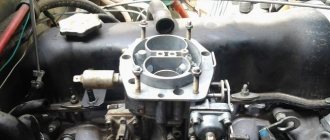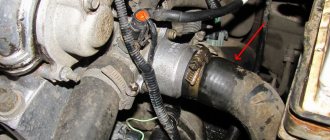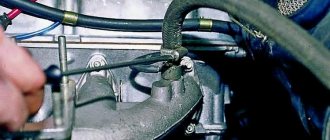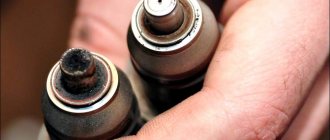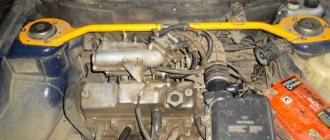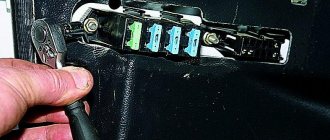VAZ 2114 idle speed fluctuates: causes of malfunction and ways to solve the problem
The five-door hatchback VAZ 2114 is a restyled model of the famous “nine”, which rolled off the assembly line of the car plant from 2003 to 2013. At various times, the manufacturer installed on the car power plants with carburetor or distributed fuel injection (injector) of its own making, and since 2007 the car has been equipped with an electronic engine control system. Note that all these engines have one common and very significant drawback - when they switch to idle mode, their crankshaft speed suddenly begins to “float”.
Idle mode
Idle speed is the operating mode of a car engine with the gear in neutral. It is characterized by minimal engine load and low fuel consumption.
Idle mode is used:
- for delivering motor oil from the engine crankcase to friction units after a long period of parking the vehicle;
- to warm up the power unit in the cold season;
- in cases where turning off the motor is impossible or undesirable.
During normal engine operation, the crankshaft speed is idling at 2000 rpm. gradually decrease to 800, then maintaining at this level. However, it also happens that the power plant, when switching to this mode, operates unstably - it randomly changes the speed in the range of 500–1500 rpm, “chokes” and stalls. This tells us: a failure has occurred in the engine control system, the causes of which must be diagnosed and eliminated as soon as possible.
The movement of the arrow of the device shows the change in the number of engine revolutions
Determining the specific cause of the malfunction is not easy, but it cannot be ignored - this can lead to critical engine failure and the need for expensive repair work. In addition, driving a car with an engine that is unstable at idle speed distracts the driver's attention. He has to constantly monitor changes in the speed and keep his foot on the gas pedal, preventing the engine from stalling when braking or stopping briefly.
Diagnostic sequence
There are no exact recommendations for the diagnostic sequence. If the engine stalls periodically, it is better to wait a little time and try to find out what the problem is. It is not difficult to determine a malfunction in the operation of an internal combustion engine - electronic diagnostic systems allow the electronic control unit to record problems. Verification methods based on visual and auditory observations should be kept in mind. The presence of extraneous noise, changes in the color of gas exhaust and other signs indicate a malfunction of the engine. Car owners with extensive driving experience know that minor faults lead to big problems - major engine repairs or complete replacement. Periodic inspections of parts and components of the unit, which are recommended to be carried out once a week, help to avoid such problems:
- check the level of engine oil and antifreeze;
- inspect for damage and ruptures of tips, connectors, hoses;
- monitor the operation of gaskets and seals.
To determine the reason for the engine stopping at idle, you must:
- First, carefully examine the engine and the space under the hood (pay special attention to inspecting the wiring parts).
- Next, check the condition of the air and fuel filters (at the same time, check the level of liquids in the cooling and ventilation systems).
- Then warm up the engine to a high temperature, press the gas pedal - a change in the color of the exhaust gases to white, grey, gray or blue indicates problems in the internal combustion engine.
It wouldn't hurt to check the engine for various noises. To do this, it is better to use a stethoscope or a regular device made of a wooden stick with a small metal or plastic container attached to the end. This will help you hear how the engine works. In the process of studying sound, it will not be superfluous to determine how the engine sounds - ringing or dull.
In cases where it is not possible to solve the problem on your own, it is better to send the car to a service station.
Causes of malfunction
Among the reasons leading to improper engine operation in idle mode are problems with sensors that transmit information to the electronic control unit . These include sensor malfunctions:
- idle speed controller (IAC);
- mass air flow (MAF);
- crankshaft position (CPCV);
- throttle valve position;
- vehicle speed (VSA).
The appearance of floating crankshaft speeds also causes:
- malfunction of the idle speed solenoid valve;
- dirty air filter and spark plugs;
- damage to high-voltage wires;
- wear of gaskets and plugs at the junction of the intake manifold with the cylinders;
- malfunction of the EGR valve, which regulates exhaust gas emissions.
We are looking for the cause in the sensors
There are many reasons why the idle speed of the VAZ 2114 jumps. But it’s better to start your search by checking the sensors. The VAZ 2114 often suffers from failures in the operation of sensors (one or several at once) - the electronics do not receive the necessary information, and the system fails.
Mass air flow sensor
Practice shows that most often (in 80 cases out of 100) the engine speed jumps at idle due to a failure of the mass air flow sensor (MAF). You can check the functionality of the sensor in two ways - by disconnecting the sensor and measuring the voltage at the output of the connected sensor using a multimeter (tester).
Methods for eliminating floating engine speeds
When starting to find and eliminate the reasons that cause unstable operation of the engine in idle mode, you first need to check:
- Condition of the air filter and spark plugs. If they become critically dirty, they need to be replaced.
- Integrity of insulation of high-voltage wires. If damage is found, they must be replaced.
It is recommended to make sure that there is no suction at the junction of the intake manifold with the engine cylinders. To do this, with the engine running, you need to sequentially spray all joints at the joints with carburetor cleaner or other flammable liquid. If atmospheric air enters there, the car engine jerks sharply, which is why, if a damaged gasket or plug is detected, the element is replaced.
Checking the tightness of the intake manifold (video guide)
Let's consider the remaining elements of the car, the malfunction of which can affect the smooth operation of the VAZ 2114 engine in idle mode.
Solenoid valve diagnostics
Cars with engines equipped with a carburetor are equipped with idle speed solenoid valves. Devices are checked as follows:
- Disconnect the power cord.
- Start the engine to warm up.
- Connect the wire. If a clear click is not heard, the part must be replaced.
Attention! To fully ensure that the valve is working properly, be sure to clean the nozzle and repeat the test.
Adjusting the idle speed on a carburetor engine (with video)
Note that the main reason for the appearance of floating idle speed in engines of this type is the incorrect operation of the carburetor. The device is adjusted by rotating the fuel quality and quantity screws.
Is the EGR system on the injector working?
"Floating" speed can be caused by jamming of the exhaust gas recirculation (EGR) valve, which is installed in the exhaust manifold. It is necessary to periodically remove dirt from the valve seat and its seat using a carburetor cleaning aerosol, avoiding liquid getting on the sensor diaphragm.
Keep the valve seat clean
Attention! If cleaning the unit does not give a positive result, the device must be replaced.
Is the idle air control valve working correctly?
The IAC is checked by measuring the electrical resistance at the contacts - to diagnose the device you will need a tester (multimeter) set to the “ohmmeter” operating mode. To check the details:
- Let's turn off the ignition.
- Disconnect the connection block.
- Let's measure the resistance on contacts A - B and C - D of the device. The optimal readings of the device vary from 40 to 80 ohms.
- Let's repeat the measurements with contacts B - C and A - D. In this case, the multimeter should show “infinity” or an open circuit.
Do-it-yourself troubleshooting
If the idle speed of your VAZ 2114 fluctuates, then the search for causes should be carried out in the following order. First you should check the condition of the spark plugs. Very often they can lead to such a problem. If the spark plugs are oxidized, have carbon deposits or other contaminants, they should be cleaned and engine operation checked. An even more accurate check can be carried out by replacing old spark plugs with new ones.
Difference between new and old candle
If the spark plugs are in order, then you need to check the integrity of the armor wires and, if broken, replace them. The next step is to check the air filter. If it is heavily soiled or damaged, it should also be replaced with a new one. If after such replacements the motor still does not work stably, then you should proceed to checking the electronic elements.
Broken wiring
There are as many as fourteen reasons why a cold engine has high speeds for a long time after starting. In particular:
- Throttle valve. Air can enter the engine through a raised throttle valve when, for example, its drive cable is tightened (if it is provided for by the design). In this case, at idle speed, more than the required amount of air enters the engine, which, in fact, leads to high speeds during a cold start. Another option is to use a hard mat on the floor that can support the gas pedal without the driver pressing it. In this case, the speed will also be increased, not only when the engine is cold, but also when the engine is warm. The throttle valve may not close completely due to the fact that it is very dirty with carbon deposits. In this case, he simply will not allow it to fit tightly.
- Idle channel. All carburetor engine models are designed to have an air channel that bypasses the throttle valve. The channel cross-section is adjusted with a special adjusting bolt. Accordingly, if the channel cross-section is incorrectly adjusted, a larger than necessary amount of air will pass through the idle channel, which will lead to high engine speeds when cold. True, such a situation can be “hot”.
- Air duct to maintain high speeds of a cold engine. This channel is closed using a rod or valve. Accordingly, the position of the rod or the angle of the damper depends on the temperature of the antifreeze in the cooling system (that is, essentially, the temperature of the engine). When the engine is cold, the channel is completely open, and accordingly, a large amount of air flows through it, providing increased speed when cold. As the engine warms up, the channel closes. If the rod or damper does not completely block the flow of additional air, this will lead to increased engine speed.
- Intake manifold air duct. In different motor designs, it is closed by a servomotor, a pulse motor, a solenoid valve, or a pulse-controlled solenoid. If these elements fail, the air channel will not be blocked properly, and accordingly, a large amount of air will pass through it into the intake manifold.
- Intake manifold pipes. Often, excess air enters the system due to depressurization of the pipes or their connection points. This can usually be determined by the whistling sound coming from there.
- In some cars, for example Toyota, the engine design provides for the use of electric motors for forced idle speed increase. Their models and management methods vary, but all have a separate management system. Therefore, the problem of high idle speed may be associated either with the specified electric motor or with its control system.
- Throttle position sensor (TPS or TPS). They come in four types, but their main task is to transmit information to the engine control unit about what position the damper is in at a particular moment in time. Accordingly, if the TPS malfunctions, the ECU goes into emergency mode and gives a command to supply the maximum amount of air. This leads to the formation of a lean air-fuel mixture, as well as high engine idle speeds. Often, the speed may “float” during operation. The speed may also increase when the throttle settings are reset.
- Idle speed regulator. These devices come in three types - solenoid, stepper and rotary. Typically, the causes of IAC malfunction are damage to its guide needle or damage to its electrical contacts.
- Mass air flow sensor (MAF). If this element partially or completely fails, the control unit will also receive incorrect information about the amount of air supplied to the engine. Accordingly, a situation may arise where the ECU decides to open the throttle more or fully to increase air flow. This will naturally cause the engine speed to increase. If the mass air flow sensor operates unstable, the speed may not only be increased “when cold,” but also be unstable in other engine operating modes.
- Intake air temperature sensor (ДТВВ, or IAT). The situation is similar to other sensors. If incorrect information is received from it by the control unit, the ECU cannot issue commands to form optimal speeds and create an air-fuel mixture. Therefore, it is likely that if it malfunctions, increased idle speed may appear.
- Coolant temperature sensor. If it fails, information will be supplied to the ECU (or generated automatically) that the antifreeze or antifreeze has not yet warmed up enough, so the engine will operate at higher speeds in order to supposedly warm up to operating temperature.
- Reduced efficiency of the water pump. If for any reason its performance has decreased (it has begun to pump an insufficient amount of coolant), for example, the impeller has worn out, then the cold engine warm-up system will also work ineffectively, and therefore the engine will operate at high speeds for a long time. An additional sign of this is that the stove in the cabin heats only when the gas pedal is pressed, and at idle it cools down.
- Thermostat. When the engine is not warmed up, it is in a closed state, allowing coolant to circulate only through the engine. When the antifreeze reaches operating temperature, it opens and the liquid is further cooled while passing through the full circle of the cooling system. But if the liquid initially moves in this mode, the engine will run longer at higher speeds until it warms up completely. Reasons for a thermostat malfunction may be that it is stuck or does not close completely.
- Electronic control unit. In rare cases, the ECU may be the cause of high engine speeds when starting the engine. In particular, a malfunction of its software or mechanical damage to its internal components.
When starting to find and eliminate the reasons that cause unstable operation of the engine in idle mode, you first need to check:
- Condition of the air filter and spark plugs. If they become critically dirty, they need to be replaced.
- Integrity of insulation of high-voltage wires. If damage is found, they must be replaced.
Let's consider the remaining elements of the car, the malfunction of which can affect the smooth operation of the VAZ 2114 engine in idle mode.
Cars with engines equipped with a carburetor are equipped with idle speed solenoid valves. Devices are checked as follows:
- Disconnect the power cord.
- Start the engine to warm up.
- Connect the wire. If a clear click is not heard, the part must be replaced.
Note that the main reason for the appearance of floating idle speed in engines of this type is the incorrect operation of the carburetor. The device is adjusted by rotating the fuel quality and quantity screws.
"Floating" speed can be caused by jamming of the exhaust gas recirculation (EGR) valve, which is installed in the exhaust manifold. It is necessary to periodically remove dirt from the valve seat and its seat using a carburetor cleaning aerosol, avoiding liquid getting on the sensor diaphragm.
Keep the valve seat clean
The IAC is checked by measuring the electrical resistance at the contacts - to diagnose the device you will need a tester (multimeter) set to the “ohmmeter” operating mode. To check the details:
- Let's turn off the ignition.
- Disconnect the connection block.
- Let's measure the resistance on contacts A - B and C - D of the device. The optimal readings of the device vary from 40 to 80 ohms.
- Let's repeat the measurements with contacts B - C and A - D. In this case, the multimeter should show “infinity” or an open circuit.
Any violation of the normal resistance values means a malfunction of the regulator. IAC failure is a common cause of floating engine speed at idle, and if a malfunction is detected, the device must be replaced. Before you begin dismantling the part, you must disconnect the negative wire from the battery.
IAC failure is a common cause of floating engine speeds.
Serviceability of the mass air flow sensor
Idling
Idling of a car is the operation of its engine when the gear is in neutral. At the same time, the fuel load, as well as the load on the engine, is minimal.
Idling is used in several cases:
- To “bleed” the oil after the car has been parked for a long time.
- To warm it up during cold weather.
- To keep the engine running for a long time without driving the vehicle.
Engine idle operation looks like this: first, the speed quickly rises to 2,000 or even 2,500 rpm, after which it gradually decreases and stops around the 800 rpm mark.
This type of engine operation is absolutely normal. If, in idle mode, the VAZ 2114’s revolutions jump (either sharply increase or drop sharply, and the interval of “jumps” can be up to 1,500 rpm), then a malfunction has occurred in the engine system. In most cases, such a sharp fluctuation in speed leads to the engine stalling.
Despite the common opinion, driving a car with “floating” speed is unacceptable, as this can lead to serious consequences, including engine damage. When the first signs of this phenomenon appear, travel should be stopped and urgent repairs performed.
Floating speed on the carburetor
On carburetor versions of the VAZ 2114 there is no electronic control unit as such. But this does not mean at all that the problem of floating speed is not alien to him.
Tachometer with high speed
Floating speeds do not occur as often as in the case of an injector, but still. The reasons, as well as troubleshooting methods, vary.
- The idle speed is set incorrectly, or it got lost during operation. In such a situation, the setting shifts to combining the fuel-air mixture. Here you will need to adjust the speed to the range of 800-900 units.
- The solenoid valve is faulty. The engine will only run if the choke is pulled out. If you remove it, the engine will immediately stall.
- The idle jet or channels are dirty. In such a situation, the fuel lacks air. Clean the jet and the problem will go away.
- Excessive air is sucked in. The mixture becomes leaner, so the engine sputters and stalls.
- The level of gasoline in the float chamber increases or decreases.
- The air filter is clogged. The problem is solved by simply replacing the element.
The reason for the vibrations is the air-fuel mixture, which is prepared by the carburetor before being fed into the combustion chamber. Low temperatures lead to inefficient combustion of the mixture. Hence the “shaking”.
Although it is not uncommon for vibrations to occur due to the cushions, that is, the engine mounts on which it is mounted. When they wear out, vibrations are possible. Moreover, this does not depend on what type of engine is used - injection or carburetor.
You should always pay attention to the floating speed of the VAZ 2114 and not wait for the problem to manifest itself in some other way. If you delay in identifying the causes and eliminating faults, repairs can be much more expensive.
Possible reasons
There are a number of reasons why the VAZ 2114 idle floats:
- one of the sensors that regulate engine operation is faulty (these include sensors: idle speed, air flow, throttle position, crankshaft position, speed sensor);
- the air filter is damaged or dirty;
- spark plugs are faulty;
- armored wires are damaged;
- the gaskets sealing the connection of the manifold working on the inlet with the cylinder head are damaged;
- EGR valve is faulty.
Trouble-shooting
If the idle speed of your VAZ 2114 fluctuates, then the search for causes should be carried out in the following order. First you should check the condition of the spark plugs. Very often they can lead to such a problem. If the spark plugs are oxidized, have carbon deposits or other contaminants, they should be cleaned and engine operation checked. An even more accurate check can be carried out by replacing old spark plugs with new ones.
It should be remembered that the spark plugs should only be replaced as a set (all 4). It is impossible to replace only one “suspicious” or definitely faulty spark plug; all the others must be replaced as well.
If the spark plugs are in order, then you need to check the integrity of the armor wires and, if broken, replace them. The next step is to check the air filter. If it is heavily soiled or damaged, it should also be replaced with a new one. If after such replacements the motor still does not work stably, then you should proceed to checking the electronic elements.
We diagnose by eye and ear
The quality of such diagnostics greatly depends on the experience of the car enthusiast; a Soviet school driver simply learns more about the car by sound than some specialists can by conducting computer diagnostics. Even if you are not a professional, you need to find the answer to just one question - when does the car stall?
The options may be as follows:
- at idle – there can be a lot of reasons, so it’s worth using a comprehensive check, starting with operational reasons and ending with the more serious ones described above;
- it stalls when cold, but works well when hot - in this case it’s worth checking the TPS;
- stalls after warming up - usually the cause is problems with engine maintenance, this creates problems with enriching the mixture at high speeds;
- It always stalls, but only works when the pedal is pressed - this is a breakdown of the DPKV. Characteristic symptoms are tripling, operation on two cylinders and inadequate knocking of valves audible even by ear;
- the engine stops working when braking or releasing the gas pedal - most likely the problems lie in a breakdown of the TPS, which disrupts the algorithms for supplying fuel to the engine when the speed decreases sharply;
- it starts and runs at idle, but stalls when the gas pedal is pressed to the floor - this is a characteristic feature of a MAF failure, the fact is that a broken sensor forces the same amount of air at high speeds as at idle.
Idle speed control
The first thing you should check is the idle speed control. To do this, you will need a tester (multimeter) set to ohmmeter mode.
The check is performed as follows:
- turn off the ignition;
- disconnect the block;
- measure the resistance between contacts A * B and C * D of the regulator. If it is working properly, the device will show a resistance value in the range from 40 to 80 Ohms;
- measure the resistance between contacts B * C and A * D. If the regulator is operational, the ohmmeter will go off scale (on some devices an “open circuit” may be indicated).
If the results obtained during measurements differ from those given above, then the idle speed controller is broken. By the way, its failure is one of the most common reasons why the idle speed of a VAZ 2114 injector fluctuates. If a breakdown is detected, the part should be replaced with a new, similar one (since the IAC is not a repairable device). Do not forget that before starting to replace the device, you should disconnect the battery ground terminal.
After the new regulator is installed, it should be “calibrated”. To do this, turn on the ignition for 10 seconds and then turn it off. There is no need to start the engine.
Why does the VAZ 2115 speed fluctuate?
- Registration
- Entrance
- To the beginning of the forum
- Forum Rules
- Old design
- FAQ
- Search
- Users
Well, I stepped away from the computer for a minute.
You can't sit at the computer all day. Yes, most likely it is IAC. Moreover, the change in steps is shown. First, take it off and clean it, and then we'll see. I think there is no need to change it for now.
Come on, good luck!


